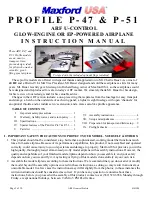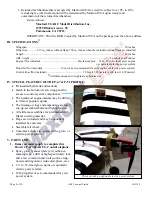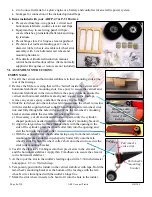
Page 8 of 10
ARF U-control Profile
S141208
7.
Use pliers to crimp each tube onto its cable. Snip off the excess elevator
cable
‟
s ends with a pair of cutting pliers and discard the excess cable.
(NOTE: For your safety, do NOT leave any strands of wire poking out from
the end of the crimp tubes. Exposed small steel strands can be sharp enough
to cut or abrade skin!)
8.
Install the elevator pushrod.
a)
Guide the straight end of the supplied
1.5 mm pushrod through the slot in the
bottom of the right-side wing’s trailing
edge.
b)
As shown at the right, guide this
pushrod into the EZ-Link connector on
the bellcrank.
c)
Snug the EZ-Link connector’s
clamping bolt onto the end of the
1.5 mm pushrod.
d)
Guide the pushrod’s Z-bend
into the outer hole in the
elevator’s control horn.
e)
Slide a length of heat-shrink
tubing onto the free end of
the pushrod.
f)
Insert the end of the wire
pushrod with the “L-bend”
into the hole in the wooden
pushrod.
g)
Secure the metal pushrod into
its hole with CA adhesive.
h)
Slide the tubing over the wire pushrod and shrink the tubing to secure the pushrod assembly as shown
above.
i)
Adjust the length of the pushrod by centering the bellcrank and positioning the 1.5 mm pushrod in its
EZ-Link connector to set the elevator to “neutral” (neither UP nor DOWN).
Congratulations! Assembly is finished!
VII. SETUP AND ADJUSTMENTS:
1.
We recommend the
center of gravity (CG) should fall approx. 4 inches back
from the leading edge of
the wing for your initial flight. If necessary, move the battery and/or add weight to the nose or tail to
ensure the CG is correct. Once you have determined the final position of your battery,
secure the battery
in the equipment bay with double-sided foam tape, then
pack the area around the battery and the
receiver with soft foam rubber
to help secure and protect them against vibration.
2.
Check the Mylar
covering material’s joints and surfaces. If necessary, carefully use an iron on medium
heat to secure the edges and to tighten any loosened areas. Recheck and retighten from time to time.
3.
Review your motor controller and/or radio’s instruction manual if you require assistance with any radio-
related setup or adjustment questions.




























